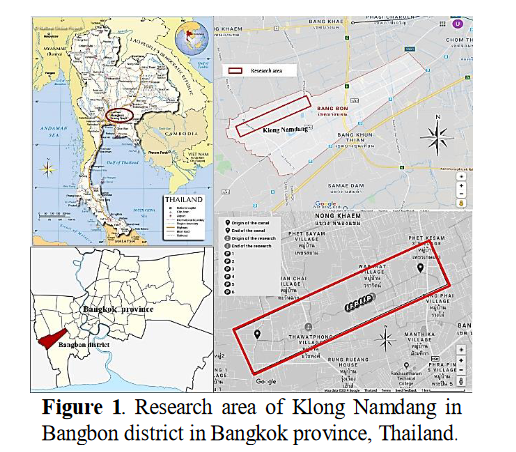Assessment of Water Quality for Drinking and Agricultural Usages in Klong Namdang Community, Bangkok, Thailand
Keywords:
Water quality, Drinking, Agriculture, NamdangAbstract
Klong Namdang is one of the important canals in Bangkok of Thailand used as agricultural area and local lifestyle since time immemorial. Nowadays, factories are increasing around the canal that may affect to environment and human health. The objectives of this research were to study quality of consumed and canal water then assess suitability for consumption and agriculture. Therefore, this work focused on determination of physical, biological and chemical qualities of 21 drinking water samples, namely tap water, rainwater and bottled drinking water from 21 households, and 6 canal water samples from Klong Namdang community. It was found that total coliform bacteria of 27% of tap water, 100% of rainwater and bottled drinking water were out of standard quality of drinking water with <3-2,400, 347.50+434.38 and 1,204.50+1,690.69 most probable number/100 ml, respectively.There were very strong correlations among electrical conductivity, hardness, calcium, magnesium, and sodium in drinking water with probability value <0.001. However, chemical qualities of canal water comprising magnesium, sodium, potassium, and manganese were out of standard of quality for agricultural water. Moreover, a correlation between total coliform bacteria and fecal coliform bacteria in the canal water was found with correlation coefficient of 0.9971 at probability value <0.001. Besides, water quality index of the canal was 53.83+2.86 meaning that it was type 4 surface water and may not be suitable for agriculture.
References
Ayers, R. S., & Westcot, D. W. (1994). Water quality in agriculture (3rd ed.). Rome: Food and Agriculture Organization of the United Nations (FAO).
Choo-in, S. (2012). Water quality management Klong Wat Rajathiwas, Dusit, Bangkok by water replacement. Bangkok: Suan Sunandha Rajabhat University.
Fosmire, G. J. (1990). Zinc toxicity. The American Journal of Clinical Nutrition, 51(2), 225-227. doi:10.1093.ajcn.51.2.225
Kallqvist, T. (2007). PNEC for metals in the marine environment derived from species sensitivity distributions (Report 5336-2007). Norway: Norwegian Institute for Water Research.
Khamsorn, D., & Chairak, C. (2013). Uptake of zinc, lead, and copper by sunflower grown in contaminated soils. KKU Science Journal, 41(2), 468-475.
Maimunkongsook, P. (2017). Basic analysis of water and waste water (2nd ed.). Thailand:
Environmental Engineering Association of Thailand.
Nateewattana, J., Nateewattana, J., Pengchai, P., Suttajit, M., Tienthavorn, V., Kim, S. D., & Kim, K. W. (2015). Risk assessment of water quality for drinking, heavy metal consuming, and agriculture utilizing to recommendation King Initiation Royal Project at Mae Pok reservoir, Sriwichai subdistrict, Li district, Lamphun province. Burapha Science Journal, 20(2), 14-32.
Nateewattana, J., Nateewattana. J., Suttajit, M., Tienthavorn, V., Kim, S. D., & Kim, K. W. (2014). Risk assessment of reservoir water for drinking and irrigation: The King Initiation Royal Project at Mae Puem reservoir, Mae Jai district, Phayao province. Journal of Science and Technology of Mahasarakam University, 33(6), 615-628.
National Environment Board. (1994). Identification of standard of water quality of surface water (8th ed.). Bangkok: Cabinet and Royal Gazette Publishing Office.
Nimrat, S., Suechamnongkitchakan, N., Supannapan, K., & Vuthipandchai, V. (2015). Assessment of physical, pH, and microbiological qualities of bottled drinking water produced in Buriram province, Thailand. RMUTP Research Journal, 9(2), 32-43.
Pattana, N., & Pongsaksri, J. (2002). Development of ceramic water filter. Pibulsongkram Rajabhat University.
Phakham, S., Wilachai, W., Silprasit, K., & Thummajitsakul, S. (2016). A study of waterborne disease classified to water consumption behaviors in Moo 7 community, Bangluksua sub-district, Ongkharak district, Nakhonnayok province. Journal of Health Science Research, 9(2), 17-23.
Polprasert, C. (2007). Water environment issues of Bangkok City, Thailand: Option for sustainable management. ScienceAsia, 33(1), 57-58.
Prasertsin, T., Waiyaka, P., Kornochalert, S., & Pukumpuang, W. (2017). Water quality analysis of mountain water supply at Nanglae Nai village, Nanglae subdistrict, Muang district, Chiang Rai province. Kasalongkham Research Journal, 11(3), 101-113.
Rice, E. W., Baird, R. B., Eaton, A. D., & Clesceri, L. S. (2012).Standard methods for the examination of water and wastewater (22nd ed.). Washington, DC: American Public Health Association, American Water Works Association, Water Environment Federation.
Rojjanaburanont, T. (1983). An environmental study on water of main canals in Bangkok. Chulabhorn Research Institute.
Shan, Y., Tysklind, M., Hao, F., Ouyang, W., Chen, S., & Lin, C. (2013). Identification of sources of heavy metals in agricultural soils using multivariate analysis and GIS. Journal of Soils and Sediments, 13, 720-729. doi:10.1007/s11368-012-0637-3
Sompong, U. (2018). Water quality after removing shops at Klong Ong Ang. RMUTI Journal Science and Technology, 11(2), 142-153.
Suwanpinij, N., & Suwanpinij, P. (2017). General microbiology (11th ed.). Bangkok: Chulalongkorn Unversity Press.
Thongthammachart, C. (1997). Water quality index. Journal of Pollution Control Department,2(1),
-12.
Wang, J., Chen, S., & Xia, T. (2010). Environmental risk assessment of heavy metal in Bohai, North China. Procedia Environmental Sciences, 2, 1632-1642. doi:10.1016.j.proenv.2010.10.174













